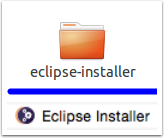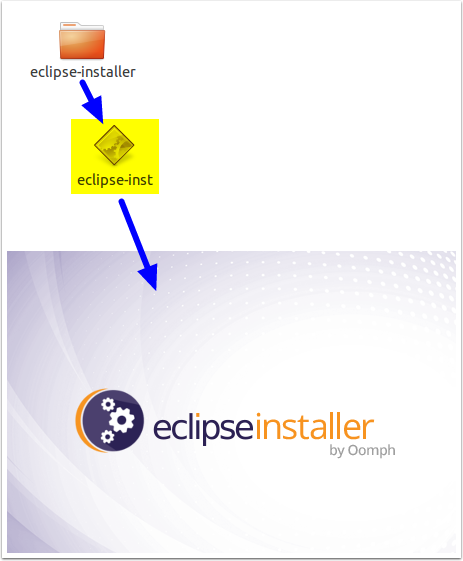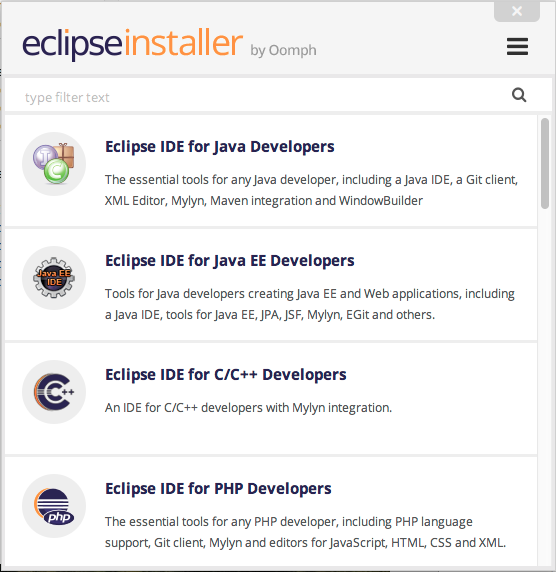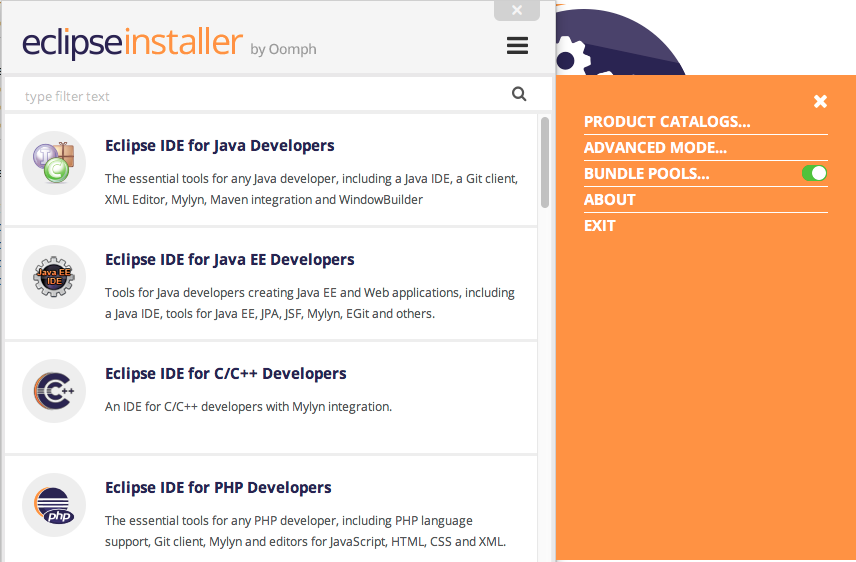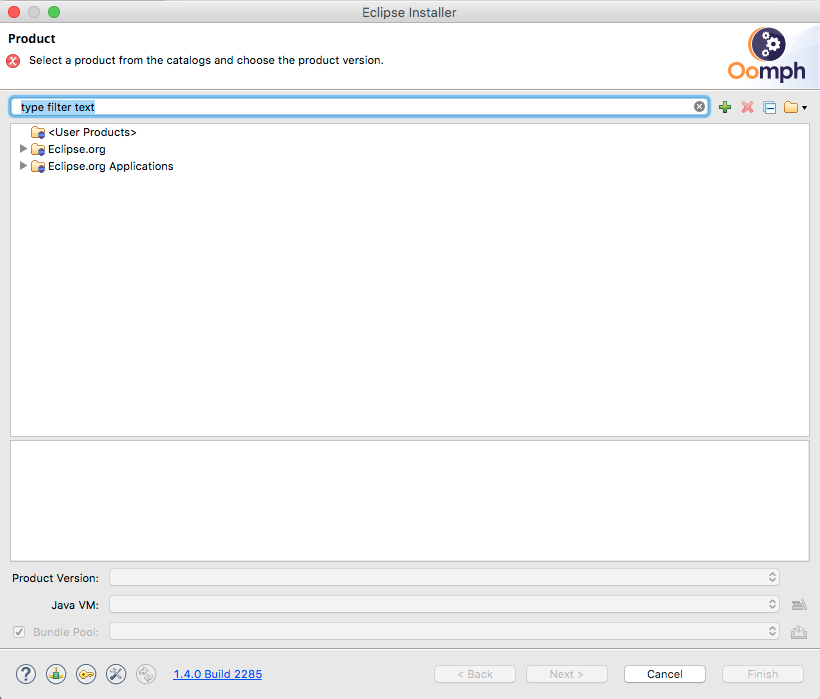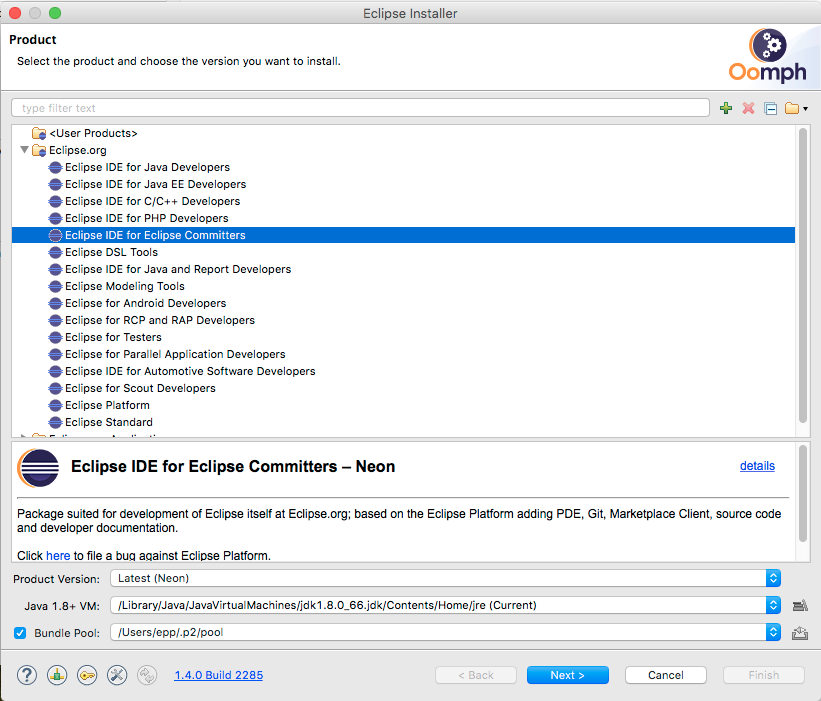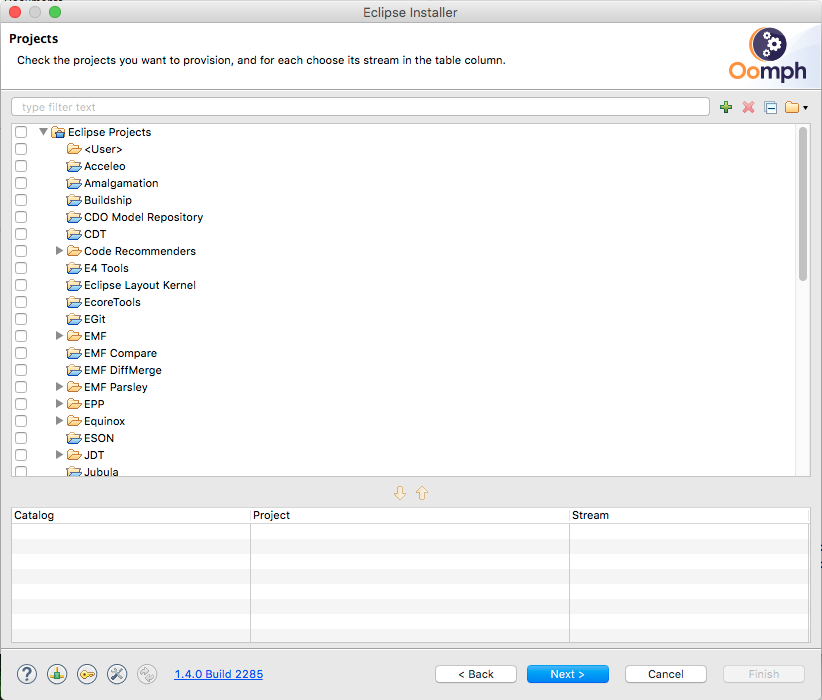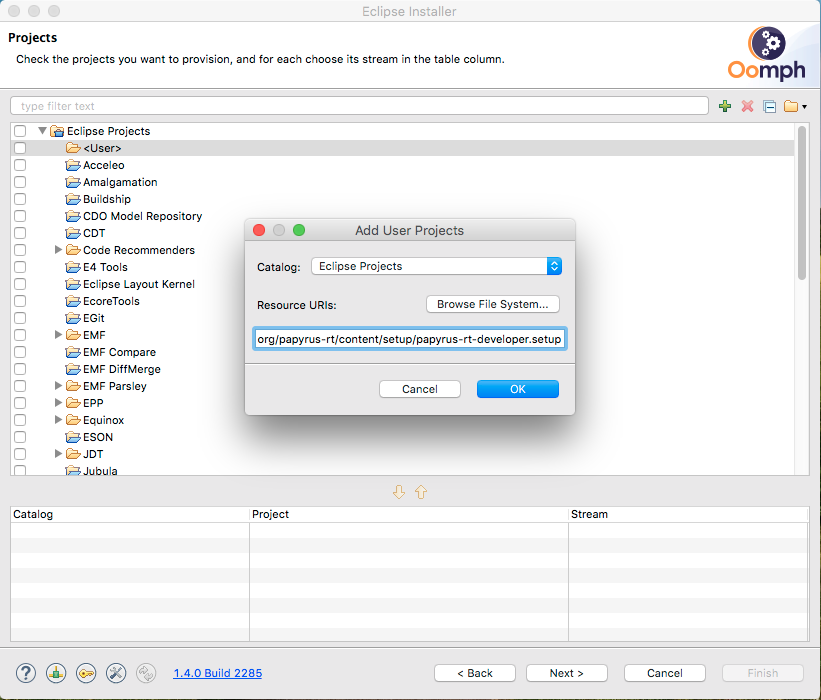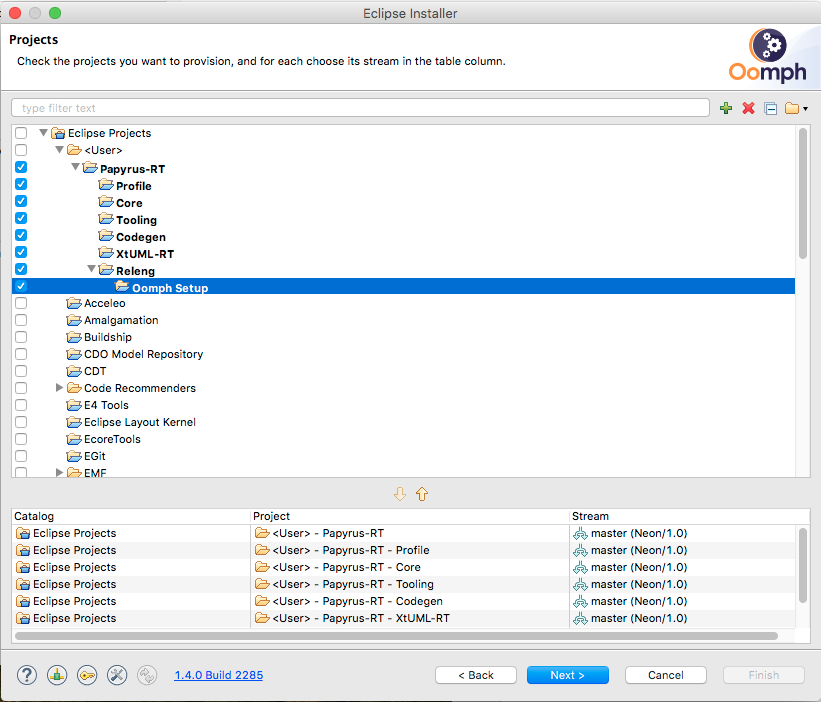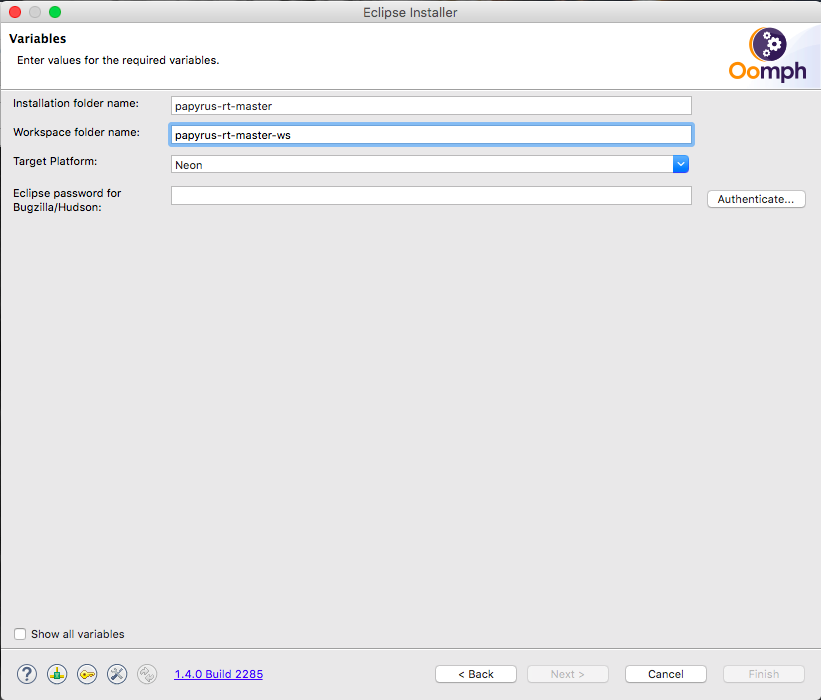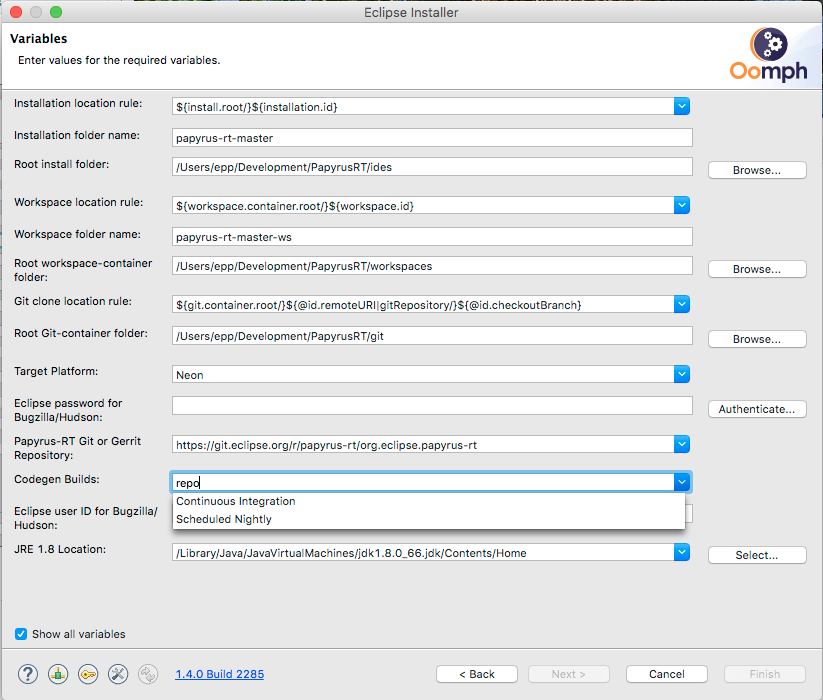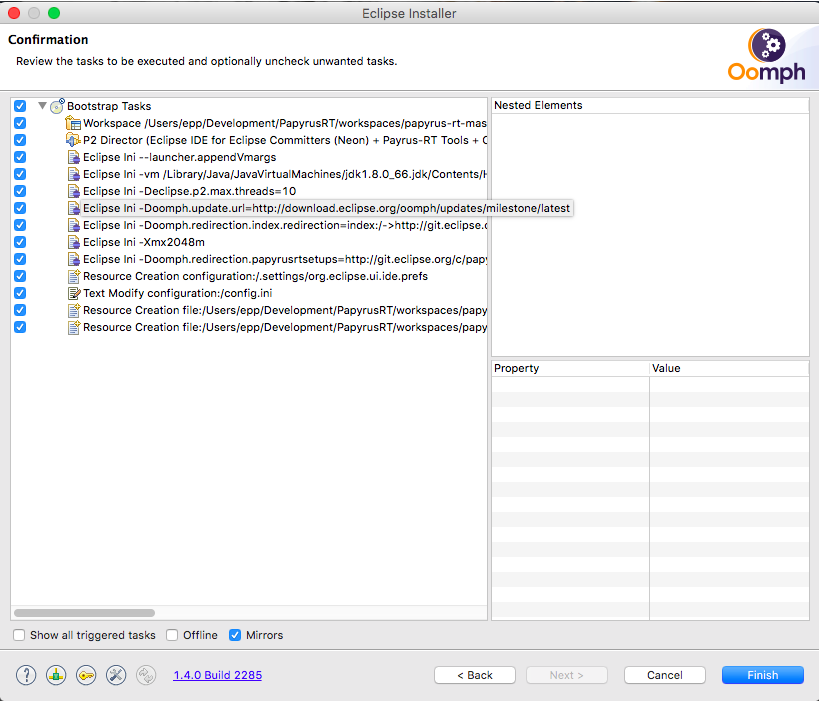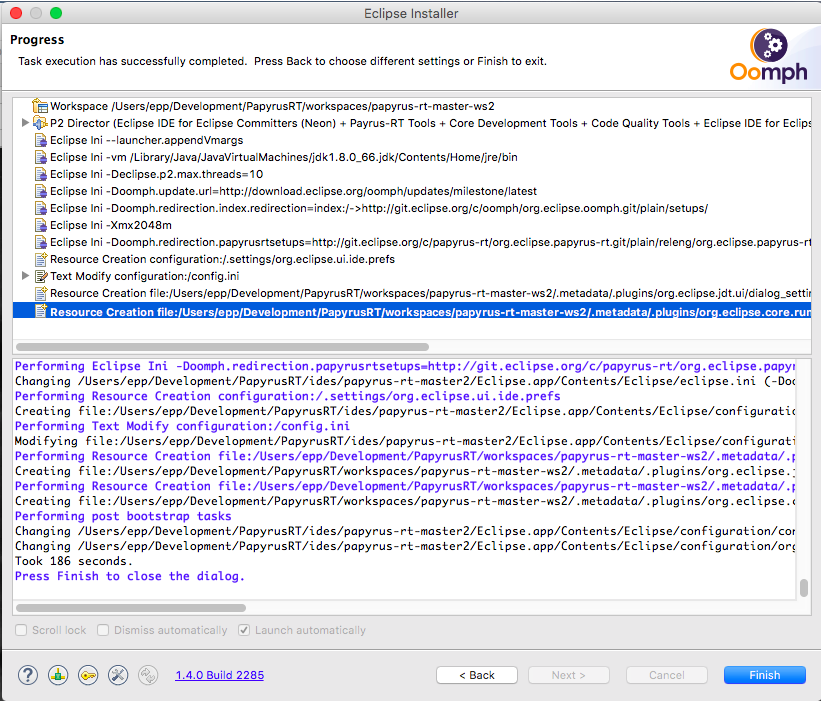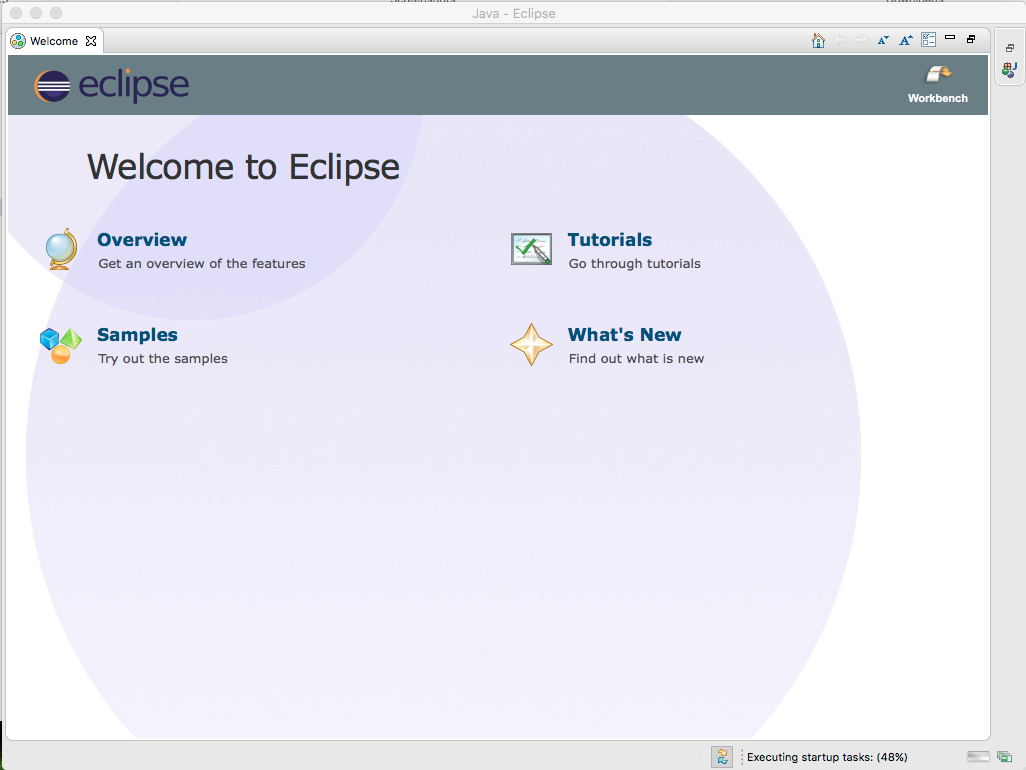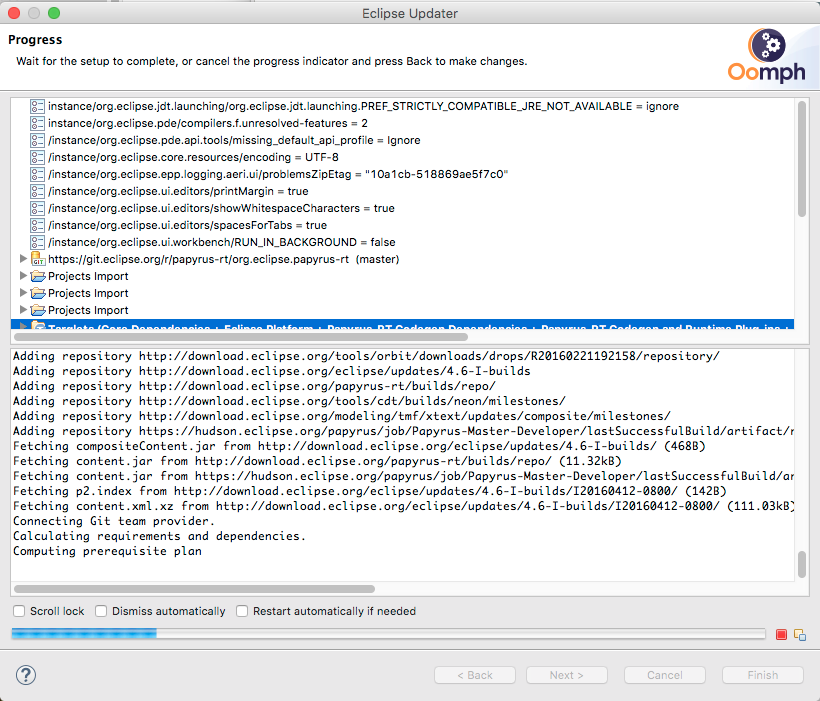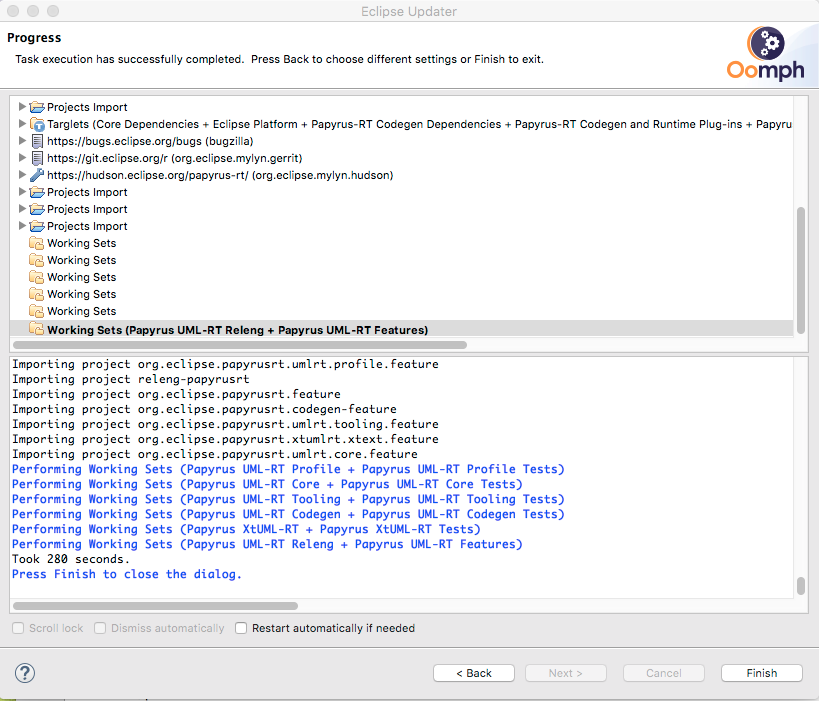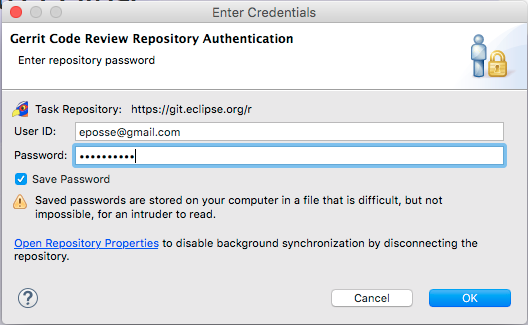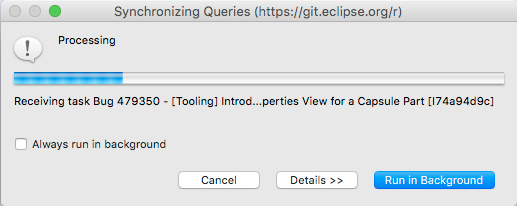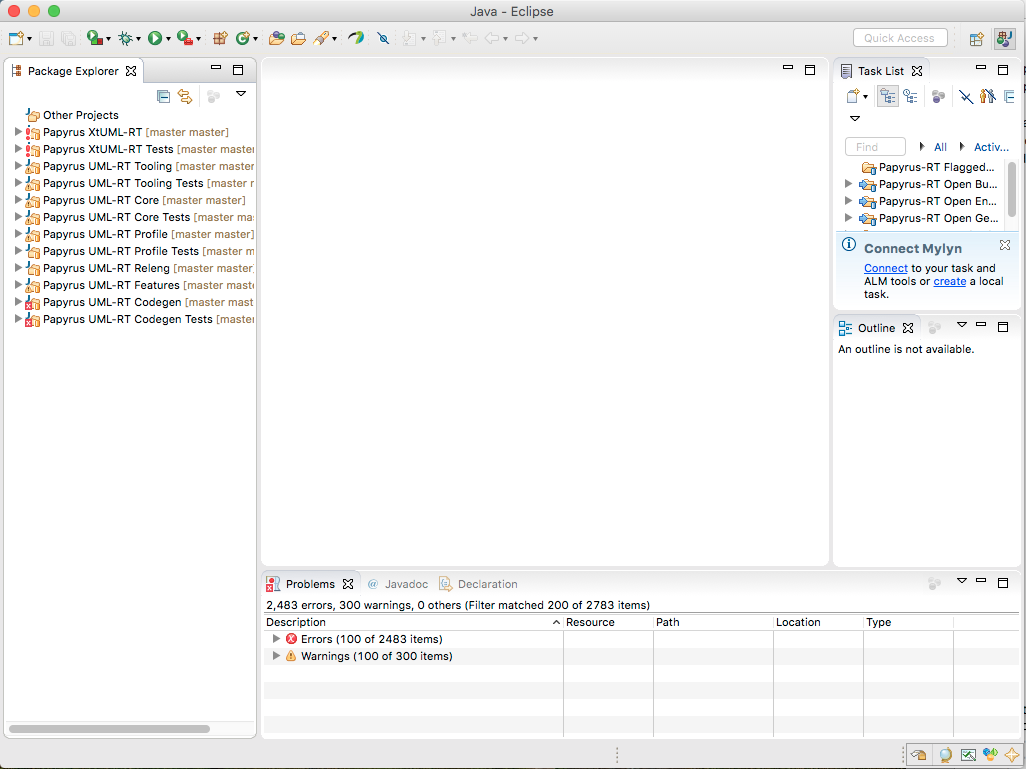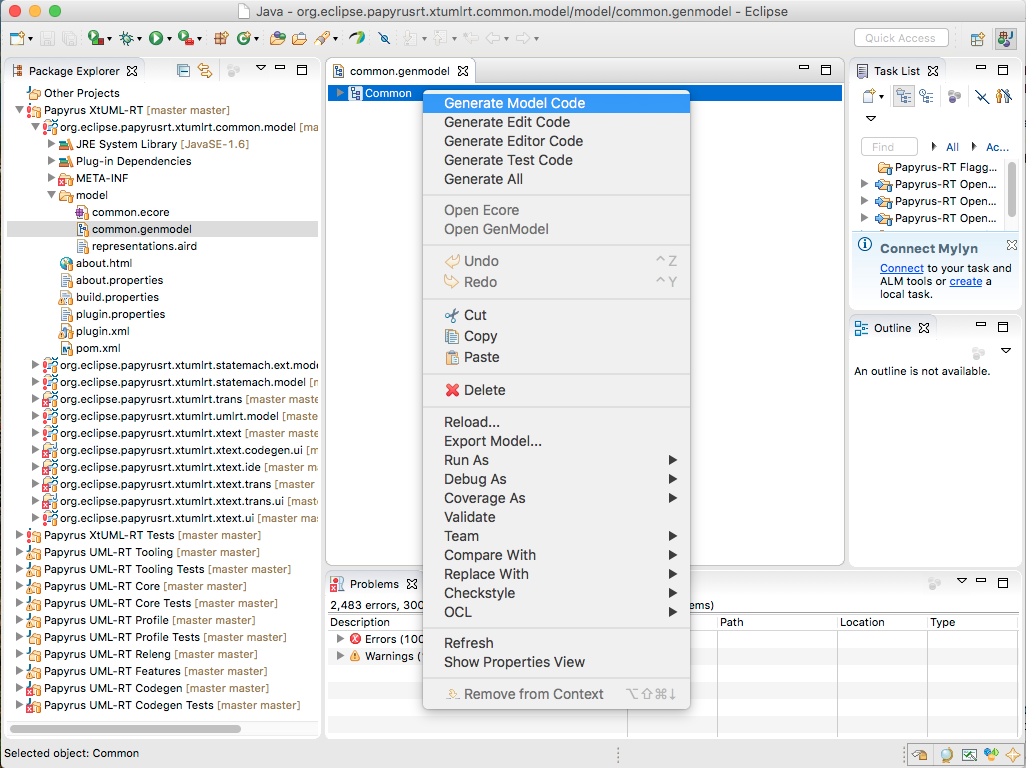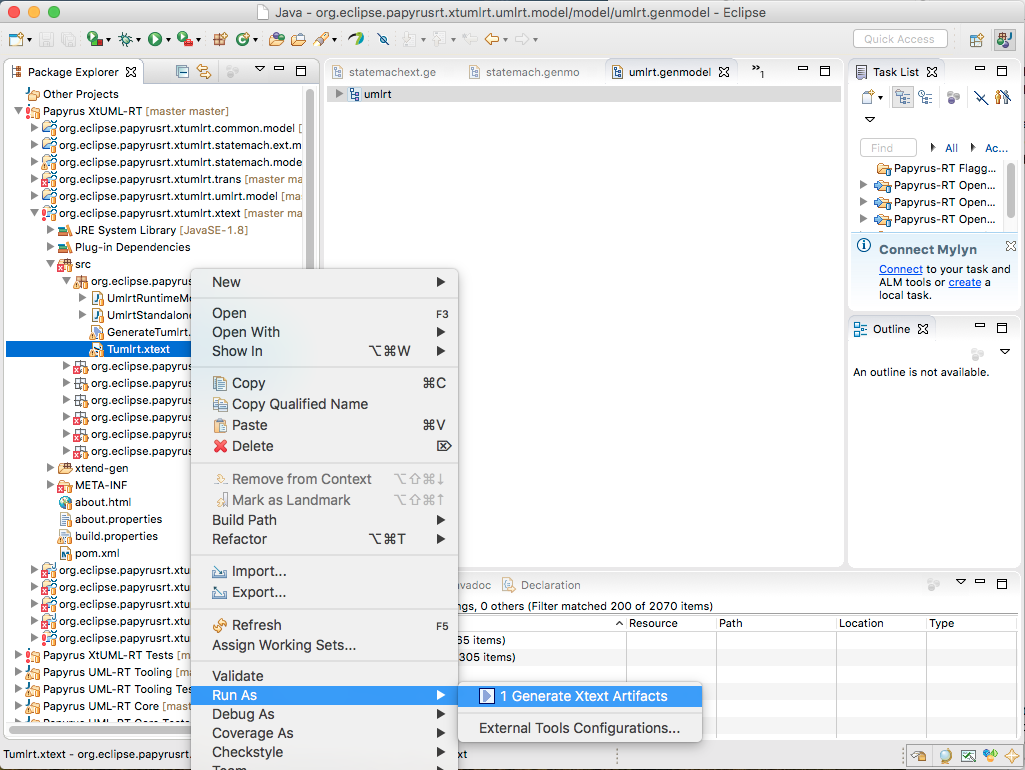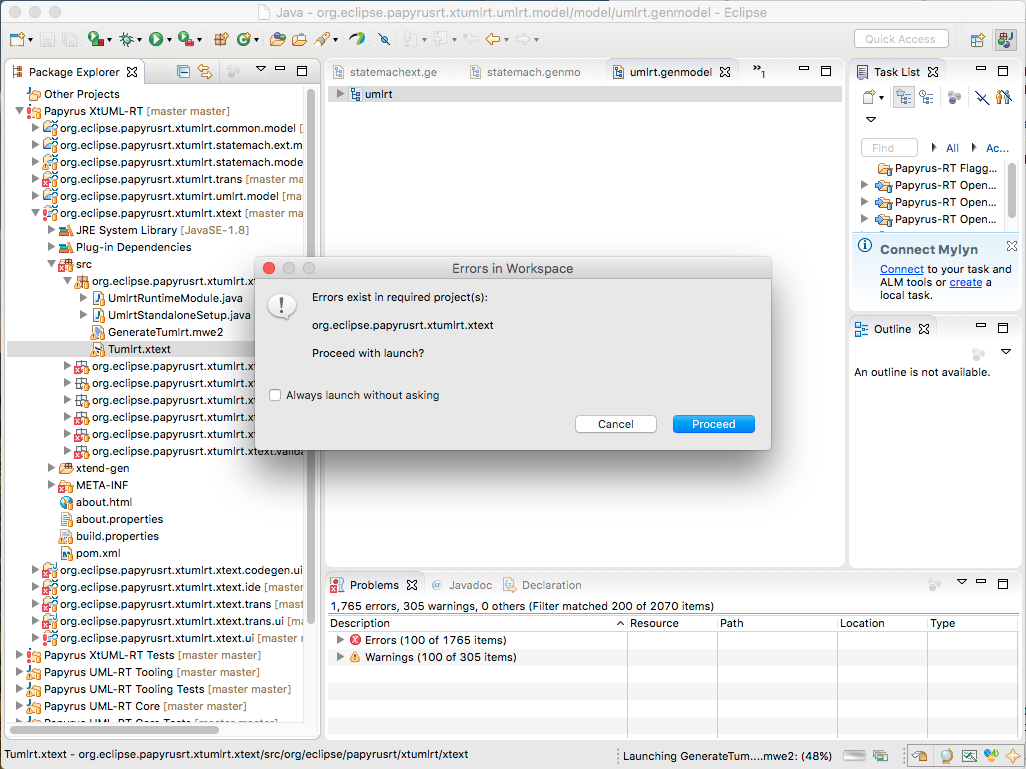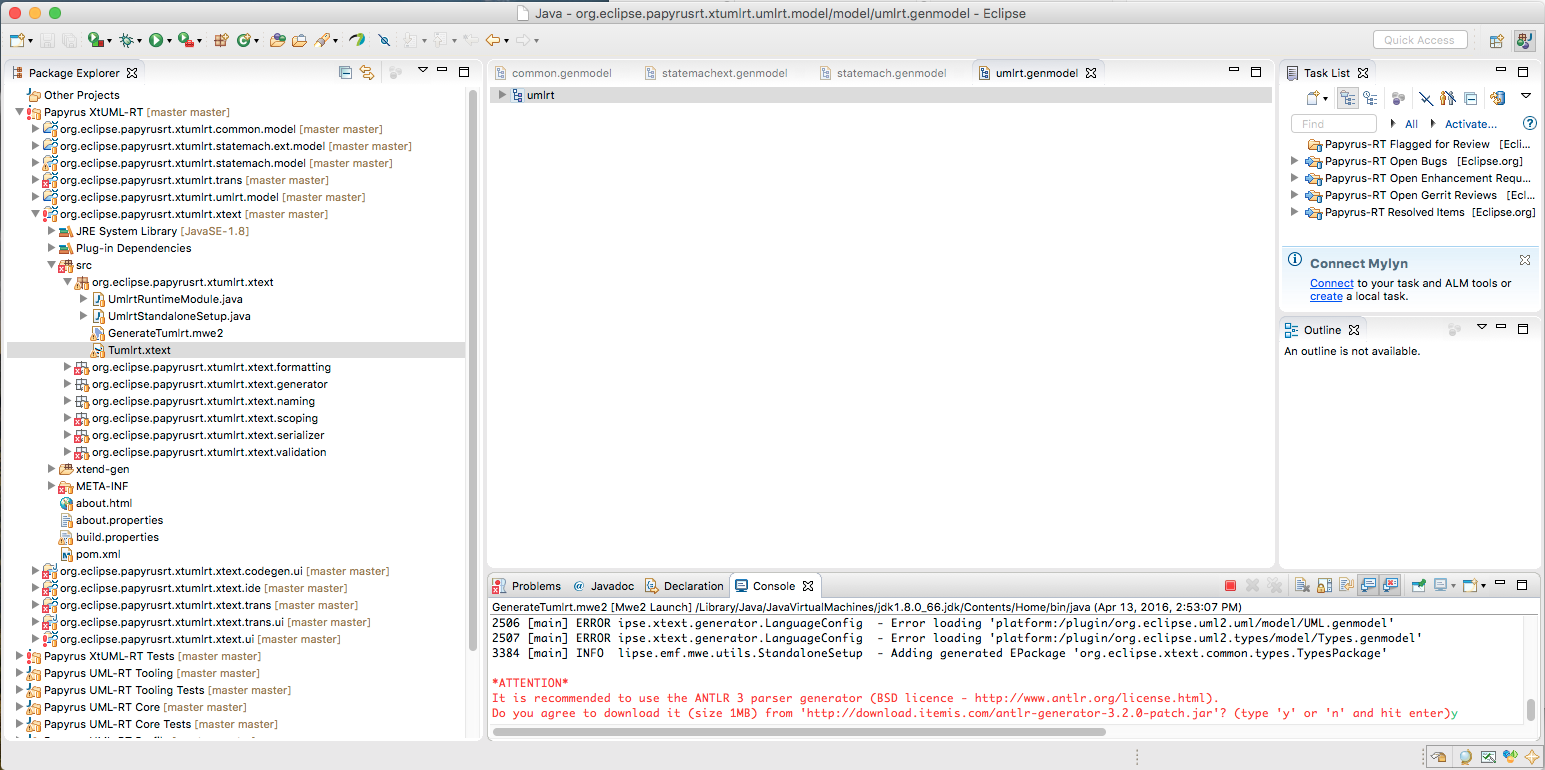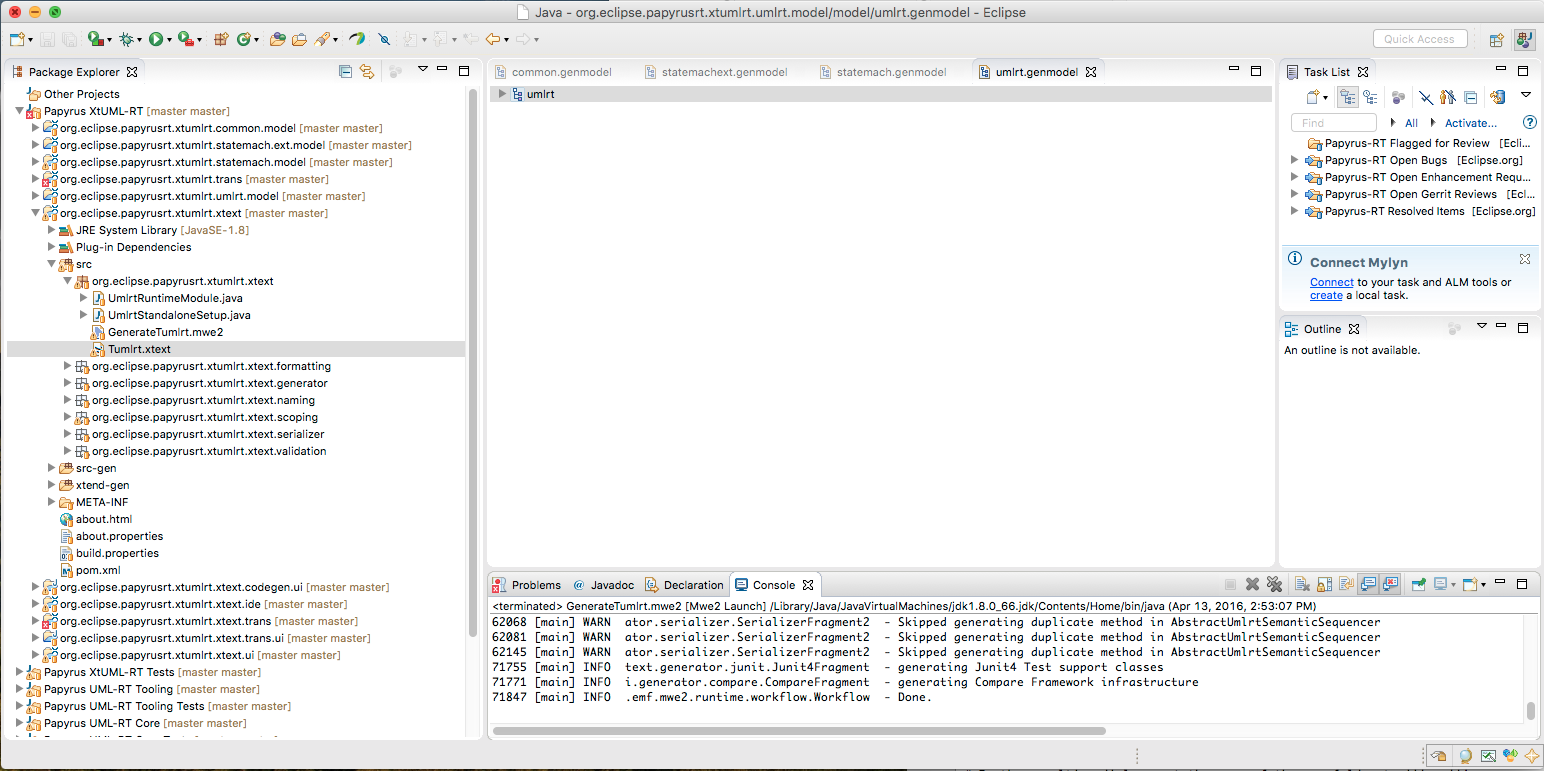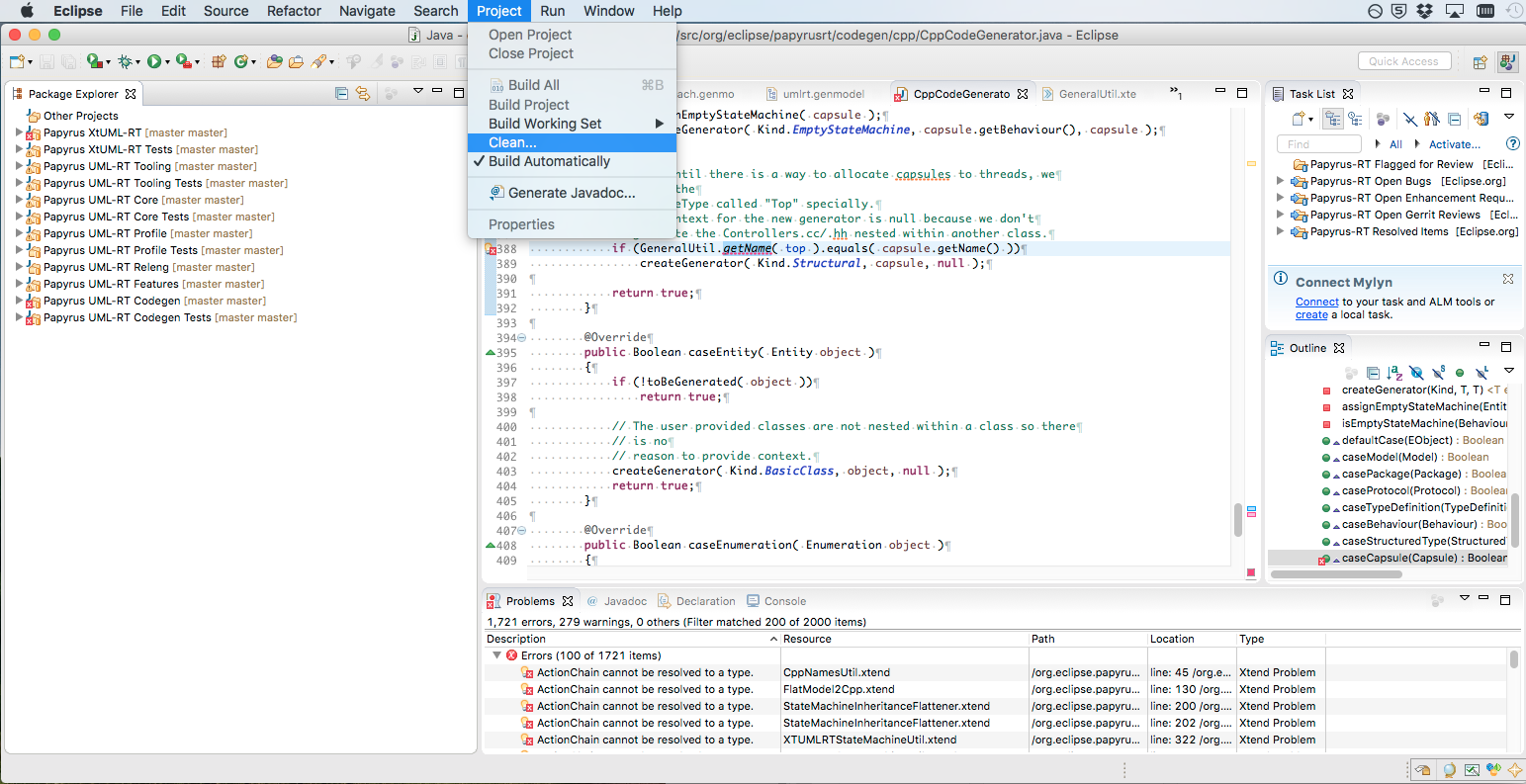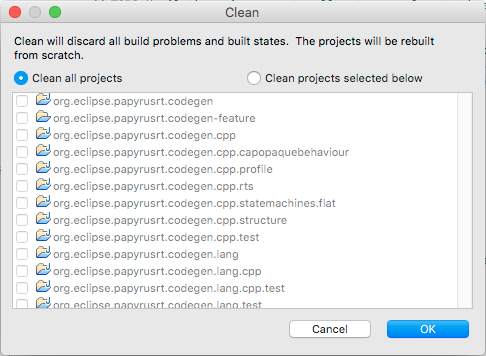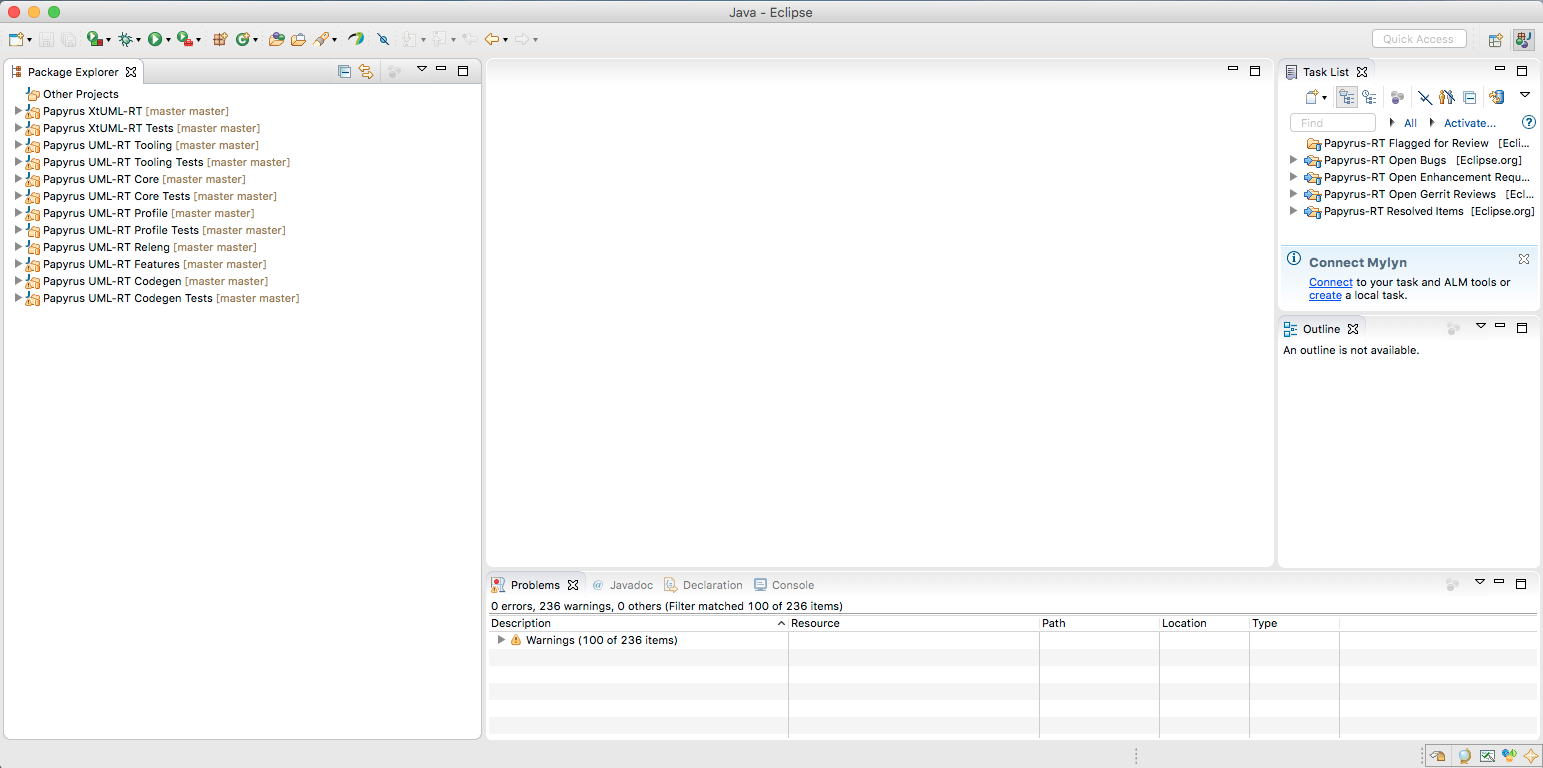Notice: this Wiki will be going read only early in 2024 and edits will no longer be possible. Please see: https://gitlab.eclipse.org/eclipsefdn/helpdesk/-/wikis/Wiki-shutdown-plan for the plan.
Difference between revisions of "Papyrus-RT/Developer/Developer Guide/DevEnv"
m |
m |
||
| Line 36: | Line 36: | ||
{{Note | Windows | We have had reports that these instructions fail on the next step on some Windows installations and we are investigating. If that is the case for you, You can first try using Java 8 and, if it still does not work, please follow the instructions on the manual installation tutorial: [[Papyrus-RT/Developer_Guide/DevEnv_Neon_Manual | Installing the Neon developer environment for PapyrusRT manually]].}} | {{Note | Windows | We have had reports that these instructions fail on the next step on some Windows installations and we are investigating. If that is the case for you, You can first try using Java 8 and, if it still does not work, please follow the instructions on the manual installation tutorial: [[Papyrus-RT/Developer_Guide/DevEnv_Neon_Manual | Installing the Neon developer environment for PapyrusRT manually]].}} | ||
| − | <div class="figure">[[Image:PapyrusRT-O-EclipseInstaller.png]] | + | <p><div class="figure">[[Image:PapyrusRT-O-EclipseInstaller.png]] |
</div> | </div> | ||
| Line 48: | Line 48: | ||
1. Open the '''eclipse-installer''' folder and double-click on the '''eclipse-inst''' application. | 1. Open the '''eclipse-installer''' folder and double-click on the '''eclipse-inst''' application. | ||
| − | <div class="figure">[[Image:PapyrusRT-O-StartSclipseInstaller.png]] | + | <p><div class="figure">[[Image:PapyrusRT-O-StartSclipseInstaller.png]] |
</div> | </div> | ||
You should see this: | You should see this: | ||
| − | <div class="figure">[[Image:papyrus-rt-dev-env-install-1.png]] | + | <p><div class="figure">[[Image:papyrus-rt-dev-env-install-1.png]] |
</div> | </div> | ||
| Line 64: | Line 64: | ||
2. Click on the icon at the top right. | 2. Click on the icon at the top right. | ||
| − | <div class="figure">[[Image:papyrus-rt-dev-env-install-2.png]] | + | <p><div class="figure">[[Image:papyrus-rt-dev-env-install-2.png]] |
</div> | </div> | ||
| Line 71: | Line 71: | ||
This has for effect to restart the Eclipse Installer in the "Advanced Mode", which will allow you to specify an external setup file. | This has for effect to restart the Eclipse Installer in the "Advanced Mode", which will allow you to specify an external setup file. | ||
| − | <div class="figure">[[Image:papyrus-rt-dev-env-install-3.png]] | + | <p><div class="figure">[[Image:papyrus-rt-dev-env-install-3.png]] |
</div> | </div> | ||
| Line 82: | Line 82: | ||
6. Select '''Eclipse IDE for Eclipse Committers'''. | 6. Select '''Eclipse IDE for Eclipse Committers'''. | ||
| − | <div class="figure">[[Image:papyrus-rt-dev-env-install-4.png]] | + | <p><div class="figure">[[Image:papyrus-rt-dev-env-install-4.png]] |
</div> | </div> | ||
| Line 93: | Line 93: | ||
9. Click '''[Next]''' | 9. Click '''[Next]''' | ||
| − | <div class="figure">[[Image:papyrus-rt-dev-env-install-5.png]] | + | <p><div class="figure">[[Image:papyrus-rt-dev-env-install-5.png]] |
</div> | </div> | ||
| Line 101: | Line 101: | ||
10. Drag and drop the setup file ([[File:papyrus-rt-developer.setup]]) onto the '''<User>''' folder. | 10. Drag and drop the setup file ([[File:papyrus-rt-developer.setup]]) onto the '''<User>''' folder. | ||
| + | <p><div class="figure">[[Image:papyrus-rt-dev-env-install-5-1.png]] | ||
| + | </div> | ||
=== Select the components to install === | === Select the components to install === | ||
| Line 108: | Line 110: | ||
12. In the bottom of the dialog make sure that the ''Stream'' field in each entry is set to '''master (Neon/1.0)''' (You may need to click on each and select the appropriate stream). | 12. In the bottom of the dialog make sure that the ''Stream'' field in each entry is set to '''master (Neon/1.0)''' (You may need to click on each and select the appropriate stream). | ||
| − | <div class="figure">[[Image:papyrus-rt-dev-env-install-6.png]] | + | <p><div class="figure">[[Image:papyrus-rt-dev-env-install-6.png]] |
</div> | </div> | ||
13. Click '''[Next]'''. | 13. Click '''[Next]'''. | ||
| − | <div class="figure">[[Image:papyrus-rt-dev-env-install-7.png]] | + | <p><div class="figure">[[Image:papyrus-rt-dev-env-install-7.png]] |
</div> | </div> | ||
| Line 119: | Line 121: | ||
14. Choose your installation and workspace folders and enter your Eclipse password. You may customize these values and more by checking on '''Show all variables''' at the bottom. | 14. Choose your installation and workspace folders and enter your Eclipse password. You may customize these values and more by checking on '''Show all variables''' at the bottom. | ||
| + | |||
| + | <p><div class="figure">[[Image:papyrus-rt-dev-env-install-7-1.png]] | ||
| + | </div> | ||
| + | |||
| + | This will give your options about the location of the workbench, the workspace, the git repository, the target platform, the JVM location and the repository used for the code-generator builds (Continuous Integration or Scheduled Nightly). | ||
15. Click '''[Next]'''. | 15. Click '''[Next]'''. | ||
| − | <div class="figure">[[Image:papyrus-rt-dev-env-install-8.png]] | + | <p><div class="figure">[[Image:papyrus-rt-dev-env-install-8.png]] |
</div> | </div> | ||
| Line 129: | Line 136: | ||
16. Click '''[Finish]'''. | 16. Click '''[Finish]'''. | ||
| − | <div class="figure">[[Image:papyrus-rt-dev-env-install-9.png]] | + | <p><div class="figure">[[Image:papyrus-rt-dev-env-install-9.png]] |
</div> | </div> | ||
| Line 138: | Line 145: | ||
Eclipse will relaunch automatically and present you with a welcome screen: | Eclipse will relaunch automatically and present you with a welcome screen: | ||
| − | <div class="figure">[[Image:papyrus-rt-dev-env-install-10.png]] | + | <p><div class="figure">[[Image:papyrus-rt-dev-env-install-10.png]] |
</div> | </div> | ||
On the bottom right it says '''Executing startup tasks'''. You can leave it alone, but it will take a few minutes to complete. If you'd like to see the progress, you can click on the icon to the left of this message (two circling arrows) | On the bottom right it says '''Executing startup tasks'''. You can leave it alone, but it will take a few minutes to complete. If you'd like to see the progress, you can click on the icon to the left of this message (two circling arrows) | ||
| − | <div class="figure">[[Image:papyrus-rt-dev-env-install-11.png]] | + | <p><div class="figure">[[Image:papyrus-rt-dev-env-install-11.png]] |
</div> | </div> | ||
| Line 153: | Line 160: | ||
18. When asked for '''Gerrit Code Review Repository Authentication''' enter your Eclipse user ID and password. | 18. When asked for '''Gerrit Code Review Repository Authentication''' enter your Eclipse user ID and password. | ||
| − | <div class="figure">[[Image:papyrus-rt-dev-env-install-13.png]] | + | <p><div class="figure">[[Image:papyrus-rt-dev-env-install-13.png]] |
</div> | </div> | ||
During setup, a few dialogs like the following will pop up: | During setup, a few dialogs like the following will pop up: | ||
| − | <div class="figure">[[Image:papyrus-rt-dev-env-install-14.png]] | + | <p><div class="figure">[[Image:papyrus-rt-dev-env-install-14.png]] |
</div> | </div> | ||
| Line 167: | Line 174: | ||
20. Click on '''Workbench''' in the Eclipse Welcome page. You should see something like this: | 20. Click on '''Workbench''' in the Eclipse Welcome page. You should see something like this: | ||
| − | <div class="figure">[[Image:papyrus-rt-dev-env-install-15-1.png]] | + | <p><div class="figure">[[Image:papyrus-rt-dev-env-install-15-1.png]] |
</div> | </div> | ||
| Line 189: | Line 196: | ||
# Select '''Generate Model Code''' | # Select '''Generate Model Code''' | ||
| − | <div class="figure">[[Image:papyrus-rt-dev-env-install-15-2.png]] | + | <p><div class="figure">[[Image:papyrus-rt-dev-env-install-15-2.png]] |
</div> | </div> | ||
| Line 206: | Line 213: | ||
# Select '''Generate Xtext Artifacts''' | # Select '''Generate Xtext Artifacts''' | ||
| − | <div class="figure">[[Image:papyrus-rt-dev-env-install-15-6.png]] | + | <p><div class="figure">[[Image:papyrus-rt-dev-env-install-15-6.png]] |
</div> | </div> | ||
It will then say that there are errors and ask you is you want to proceed. | It will then say that there are errors and ask you is you want to proceed. | ||
| − | <div class="figure">[[Image:papyrus-rt-dev-env-install-15-7.png]] | + | <p><div class="figure">[[Image:papyrus-rt-dev-env-install-15-7.png]] |
</div> | </div> | ||
| Line 218: | Line 225: | ||
In the console view at the bottom, a message <span style="color: red"> *ATTENTION*</span> will appear and it will ask you if it can download the ANTLR 3 parser generator. | In the console view at the bottom, a message <span style="color: red"> *ATTENTION*</span> will appear and it will ask you if it can download the ANTLR 3 parser generator. | ||
| − | <div class="figure">[[Image:papyrus-rt-dev-env-install-15-8.png]] | + | <p><div class="figure">[[Image:papyrus-rt-dev-env-install-15-8.png]] |
</div> | </div> | ||
| Line 225: | Line 232: | ||
When it finishes generating the Xtext code it should look like this: | When it finishes generating the Xtext code it should look like this: | ||
| − | <div class="figure">[[Image:papyrus-rt-dev-env-install-15-9.png]] | + | <p><div class="figure">[[Image:papyrus-rt-dev-env-install-15-9.png]] |
</div> | </div> | ||
| Line 234: | Line 241: | ||
25. Click on '''Project → Clean...'''on the main menu. | 25. Click on '''Project → Clean...'''on the main menu. | ||
| − | <div class="figure">[[Image:papyrus-rt-dev-env-install-15-10.png]] | + | <p><div class="figure">[[Image:papyrus-rt-dev-env-install-15-10.png]] |
</div> | </div> | ||
26. Select '''Clean all projects''' | 26. Select '''Clean all projects''' | ||
| − | <div class="figure">[[Image:papyrus-rt-dev-env-install-15-11.png]] | + | <p><div class="figure">[[Image:papyrus-rt-dev-env-install-15-11.png]] |
</div> | </div> | ||
| Line 246: | Line 253: | ||
After if finishes, the workspace should have no errors and it should look like this: | After if finishes, the workspace should have no errors and it should look like this: | ||
| − | <div class="figure">[[Image:papyrus-rt-dev-env-install-15-12.png]] | + | <p><div class="figure">[[Image:papyrus-rt-dev-env-install-15-12.png]] |
</div> | </div> | ||
Revision as of 15:37, 13 April 2016
Contents
- 1 Introduction
- 2 Requirements
- 3 Install the development environment for Papyrus for Real Time
- 3.1 Start the Eclipse Installer
- 3.2 Switch the the Advanced Mode
- 3.3 Select a base Eclipse Package
- 3.4 Add the setup project file to the installer
- 3.5 Select the components to install
- 3.6 Configure your installation
- 3.7 Restarting
- 3.8 Generate code for EMF projects
- 3.9 Generate code for the Xtext project
- 3.10 Clean all
Introduction
This tutorial will show you how to setup the development environment for Papyrus for Real Time using the Oomph-based Eclipse Installer.
The installer will automatically perform several actions, including:
- Download and install a base Eclipse workbench for your platform
- Add the required update sites
- Download and install all required development tools (Eclipse features and plugins, such as the PDE, the JDT, EGit, MyLyn, etc.)
- Download and install all required dependencies (Eclipse features and plugins, such as UML2, Papyrus, Xtext, etc.)
- Clone the PapyrusRT git repository
- Import all the PapyrusRT projects into the workspace
- Create working sets in the workspace organizing the projects
- Install Bugzilla and Gerrit MyLyn connectors and synchronize queries for these connectors
- Configure the workbench (e.g. set the JVM and Java compiler compliance, set character encodings, code formatting and other user preferences)
Requirements
To install the developer environment you need only three things:
- Java 8.
- Older versions may not work. You can obtain the JDK 1.8 here: http://www.oracle.com/technetwork/java/javase/downloads/jdk8-downloads-2133151.html
- The Eclipse Installer
- Go to http://wiki.eclipse.org/Eclipse_Installer
- Download the "Eclipse Installer" package for your operating system
- Decompress the downloaded archive to a folder such as "~/Apps/EclipseInstaller/" (folder name and location will vary depending on operating system)
- The PapyrusRT developer setup project file.
- This file contains the tasks described above
- Download this file from https://www.eclipse.org/papyrus-rt/papyrus-rt-developer.setup
- Save it in a convenient folder such as "~/Apps/papyrus-rt-developer.setup/"
Install the development environment for Papyrus for Real Time
Now that the installer and project file are available, you can install the development environment.
Start the Eclipse Installer
1. Open the eclipse-installer folder and double-click on the eclipse-inst application.
<p>You should see this:
<p>Switch the the Advanced Mode
You have now started the Eclipse Installer. Now you will need to add the Papyrus-RT developer setup project file to the Installer.
However, the Papyrus-RT developer setup project is not available in the list of projects presented to you. You will have to manually add it to the list by using the "Advanced Mode" of the installer.
2. Click on the icon at the top right.
<p>3. Select "Advanced Mode..."
This has for effect to restart the Eclipse Installer in the "Advanced Mode", which will allow you to specify an external setup file.
<p>Select a base Eclipse Package
4. Select Eclipse.org from the list.
5. Click on the [>] left of Eclipse.org to unfold.
6. Select Eclipse IDE for Eclipse Committers.
<p>
7. In the bottom, under Product Version select Latest (Neon).
8. Under Java VM choose the appropriate Java 1.8 JVM (you may need to navigate through the file system to find the one you need).
9. Click [Next]
<p>
Add the setup project file to the installer
10. Drag and drop the setup file (File:Papyrus-rt-developer.setup) onto the <User> folder.
<p>Select the components to install
11. Unfold Papyrus-RT and check all the boxes on the left.
12. In the bottom of the dialog make sure that the Stream field in each entry is set to master (Neon/1.0) (You may need to click on each and select the appropriate stream).
<p>13. Click [Next].
<p>Configure your installation
14. Choose your installation and workspace folders and enter your Eclipse password. You may customize these values and more by checking on Show all variables at the bottom.
<p>This will give your options about the location of the workbench, the workspace, the git repository, the target platform, the JVM location and the repository used for the code-generator builds (Continuous Integration or Scheduled Nightly).
15. Click [Next].
<p>This shows the first set of tasks of the installation. The second set will be executed when Eclipse launches automatically.
16. Click [Finish].
<p>17. Click [Finish].
Restarting
Eclipse will relaunch automatically and present you with a welcome screen:
<p>On the bottom right it says Executing startup tasks. You can leave it alone, but it will take a few minutes to complete. If you'd like to see the progress, you can click on the icon to the left of this message (two circling arrows)
<p>When it finishes it will look like this:
18. When asked for Gerrit Code Review Repository Authentication enter your Eclipse user ID and password.
<p>During setup, a few dialogs like the following will pop up:
<p>These will setup and synchronize the various MyLyn queries for Bugzilla and Gerrit.
19. Once it's finished you can click [Finish] to close the setup dialog.
20. Click on Workbench in the Eclipse Welcome page. You should see something like this:
<p>At this point you will have errors in several projects (and in the Error Log view). To clean up all the errors, a few additional steps are necessary.
Generate code for EMF projects
21. For each of the following projects (found under the Papyrus XtUML-RT working set), perform the steps below:
-
org.eclipse.papyrusrt.xtumlrt.common.model -
org.eclipse.papyrusrt.xtumlrt.statemach.model -
org.eclipse.papyrusrt.xtumlrt.statemach.ext.model -
org.eclipse.papyrusrt.xtumlrt.umlrt.model
Steps:
- Unfold the project
- Unfold the model folder
- Open the 'XXX'
.genmodelfile (by double-clicking it), where 'XXX' is the name of the model. - In the opened EMF editor, right-click the root element (named 'XXX')
- Select Generate Model Code
- Do the same for each of the projects mentioned above.
Generate code for the Xtext project
22. Generate Xtext Artifacts:
- Locate the
org.eclipse.papyrusrt.xtumlrt.xtextproject (under the Papyrus XtUML-RT working set), and then - Unfold the project
- Unfold the src folder
- Unfold the org.eclipse.papyrusrt.xtumlrt.xtext folder
- Right-click on the Tumlrt.xtext file
- Select Run As
- Select Generate Xtext Artifacts
It will then say that there are errors and ask you is you want to proceed.
<p>23. Click [Proceed]
In the console view at the bottom, a message *ATTENTION* will appear and it will ask you if it can download the ANTLR 3 parser generator.
<p>24. Put the cursor in the console after the question and type y[Enter].
When it finishes generating the Xtext code it should look like this:
<p>Clean all
There will still be a few errors in the workspace. To get rid of them
25. Click on Project → Clean...on the main menu.
<p>26. Select Clean all projects
<p>27. Click [OK]
After if finishes, the workspace should have no errors and it should look like this:
<p>
